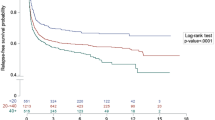Abstract
Restricted mean survival time (RMST) is often of great clinical interest in practice. Several existing methods involve explicitly projecting out patient-specific survival curves using parameters estimated through Cox regression. However, it would often be preferable to directly model the restricted mean for convenience and to yield more directly interpretable covariate effects. We propose generalized estimating equation methods to model RMST as a function of baseline covariates. The proposed methods avoid potentially problematic distributional assumptions pertaining to restricted survival time. Unlike existing methods, we allow censoring to depend on both baseline and time-dependent factors. Large sample properties of the proposed estimators are derived and simulation studies are conducted to assess their finite sample performance. We apply the proposed methods to model RMST in the absence of liver transplantation among end-stage liver disease patients. This analysis requires accommodation for dependent censoring since pre-transplant mortality is dependently censored by the receipt of a liver transplant.



Similar content being viewed by others
References
Andersen PK, Hansen MG, Klein JP (2004) Regression analysis of restricted mean survival time based on pseudo-observations. Lifetime Data Anal 10(4):335–350
Andersen PK, Perme MP (2010) Pseudo-observations in survival analysis. Stat Methods Med Res 19(1):71–99
Andersen PK (2013) Decomposition of number of life years lost according to causes of death. Stat Med 32(30):5278–5285
Binder N, Gerds TA, Andersen PK (2014) Pseudo-observations for competing risks with covariate dependent censoring. Lifetime Data Anal 20(2):303–315
Breslow NE (1972) Contribution to the discussion of the paper by D. R. Cox. J R Stat Soc Ser B 34(2):216–217
Chen P-Y, Tsiatis AA (2001) Causal inference on the difference of the restricted mean lifetime between two groups. Biometrics 57(4):1030–1038
Cox DR (1972) Regression models and life-tables. J R Stat Soc Ser B 34(2):187–220
Cox DR (1975) Partial likelihood. Biometrika 62(2):269–276
Davison AC, Hinkley DV (1997) Bootstrap methods and their application, volume 1 of Cambridge Series in Statistical and Probabilistic Mathematics. Cambridge University Press, Cambridge
Foutz RV (1977) On the unique consistent solution to the likelihood equations. J Am Stat Assoc 72(357):147–148
Gillen DL, Emerson SS (2007) Nontransitivity in a class of weighted logrank statistics under nonproportional hazards. Stat Probab Lett 77(2):123–130
Grand MK, Putter H (2015) Regression models for expected length of stay. Stat Med 35(7):1178–1192
Harrell FE, Lee KL, Mark DB (1996) Tutorial in biostatistics multivariable prognostic models: issues in developing models, evaluating assumptions and adequacy, and measuring and reducing errors. Stat Med 15(4):361–87
Heagerty PJ, Zheng Y (2005) Survival model predictive accuracy and ROC curves. Biometrics 61(1):92–105
Kalbfleisch J, Prentice R (2002) The statistical analysis of failure time data. Wiley Series in Probability and Statistics, Wiley, London
Kamath PS, Wiesner RH, Malinchoc M, Kremers W, Therneau TM, Kosberg CL, Damico G, Dickson ER, Kim WR (2001) A model to predict survival in patients with end-stage liver disease. Hepatology 33(2):464–470
Robins J, Rotnitzky A (1992) Recovery of information and adjustment for dependent censoring using surrogate markers. In: Jewell N, Dietz K, Farewell B (eds) AIDS epidemiology. Birkhuser, Boston, pp 297–331
Robins JM (1993) Information recovery and bias adjustment in proportional hazards regression analysis of randomized trials using surrogate markers. In: Proceedings of the biopharmaceutical section, American Statistical Association, vol 24, no 3. American Statistical Association
Robins JM, Finkelstein DM (2000) Correcting for noncompliance and dependent censoring in an aids clinical trial with inverse probability of censoring weighted (IPCW) log-rank tests. Biometrics 56(3):779–788
Schaubel DE, Wei G (2011) Double inverse-weighted estimation of cumulative treatment effects under nonproportional hazards and dependent censoring. Biometrics 67(1):29–38
Tian L, Cai T, Goetghebeur E, Wei L (2007) Model evaluation based on the sampling distribution of estimated absolute prediction error. Biometrika 94(2):297–311
Tian L, Zhao L, Wei L (2014) Predicting the restricted mean event time with the subjects baseline covariates in survival analysis. Biostatistics 15(2):222–233
Uno H, Cai T, Pencina MJ, Dagostino RB, Wei L (2011) On the C-statistics for evaluating overall adequacy of risk prediction procedures with censored survival data. Stat Med 30(10):1105–1117
Van Houwelingen HC (2007) Dynamic prediction by landmarking in event history analysis. Scand J Stat 34(1):70–85
Van Houwelingen HC, Putter H (2015) Comparison of stopped cox regression with direct methods such as pseudo-values and binomial regression. Lifetime Data Anal 21(2):180–196
Wiesner RH, McDiarmid SV, Kamath PS, Edwards EB, Malinchoc M, Kremers WK, Krom RA, Kim WR (2001) MELD and PELD: application of survival models to liver allocation. Liver Transplant 7(7):567–580
Wiesner R, Edwards E, Freeman R, Harper A, Kim R, Kamath P, Kremers W, Lake J, Howard T, Merion RM et al (2003) Model for end-stage liver disease (meld) and allocation of donor livers. Gastroenterology 124(1):91–96
Xiang F, Murray S (2012) Restricted mean models for transplant benefit and urgency. Stat Med 31(6):561–576
Xu R, O’Quigley J (2000) Estimating average regression effect under non-proportional hazards. Biostatistics 1(4):423–439
Zhang M, Schaubel DE (2011) Estimating differences in restricted mean lifetime using observational data subject to dependent censoring. Biometrics 67(3):740–749
Zhao L, Claggett B, Tian L, Uno H, Pfeffer MA, Solomon SD, Wei LJ (2016) On the restricted mean survival time curve in survival analysis. Biometrics 72(1):215–221
Zucker DM (1998) Restricted mean life with covariates: modification and extension of a useful survival analysis method. J Am Stat Assoc 93(442):702–709
Acknowledgements
This work was supported in part by National Institutes of Health Grant 5R01 DK070869. Data analyzed in this report were supplied by the Minneapolis Medical Research Foundation as the contractor for the Scientific Registry of Transplant Recipients. The interpretation and reporting of these data are the responsibility of the authors and in no way should be seen as an official policy of or interpretation by the Scientific Registry of Transplant Recipients or the U.S. Government.
Author information
Authors and Affiliations
Corresponding author
Electronic supplementary material
Below is the link to the electronic supplementary material.
Rights and permissions
About this article
Cite this article
Wang, X., Schaubel, D.E. Modeling restricted mean survival time under general censoring mechanisms. Lifetime Data Anal 24, 176–199 (2018). https://doi.org/10.1007/s10985-017-9391-6
Received:
Accepted:
Published:
Issue Date:
DOI: https://doi.org/10.1007/s10985-017-9391-6



